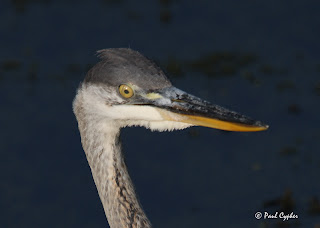In yesterday's post, I had a very cooperative Great Blue Heron only feet away. What a neat opportunity, huh? Well, after I looked through the photos again, something caught my eye. In fact, it was his eye. At least, a part of it, anyway......
Yes, the picture is not crisp, but who cares. If you look closely, he (okay, I'm not sure he's a he, but I'm gonna go with it...) has a thin, transparent thingy over his eye. It looks like an eyelid, but it is clear and working the wrong way, so it can't be an eyelid, right?
Wrong.
The nictitating membrane is basically a third eyelid found in many critters, including lots of birds, fish, reptiles, and some mammals. While I can't tell you if it was opening or closing, you can see from the photo that it works "across" the eye instead of "up and down". Basically, it is either used for extra protection or to keep the eye lubricated. (In the case of this heron, thrusting of the head into the water to nail a tadpole, frog or fish, could be dangerous. One slight jab or scrape with a stick or cattail stalk and he could have a problem.) One study even suggests that the membrane is tightened on a woodpecker's eyes milliseconds before it slams its head into a tree; it helps to hold the eyeballs in their sockets! Newton's First Law (an object in motion....) can be a drag sometimes...
You might be thinking "Wow, I wish I had one! When I slammed my forehead into my desk in frustration after I heard Glenn Beck last night, I'd swear my eyes almost flew out of my head!" Well, some biologists think we used to have this membrane, too. But, like our appendix, wisdom teeth, Darwin's Tubercle, and common sense, we basically don't use it anymore. In the case of the membrane, it has all but disappeared.
If you want to see what is left of your nictitating membrane, find a mirror. Stuffed in the corner of your eye, you'll find a small fold of basically transparent skin. That is the pilca semilunaris. Yup, that is your ancient eyeball protecting eyelid. Cool stuff. Make sure you fingers are dirty and and play with it. Don't touch it. You don't need to be sticking things in your eye! However, repeatedly saying "pilca semilunaris" goes over well at parties. Chicks dig it.
By the way, the shutter speed on the exposure was 1/1250 of a second. For the average person (read that as a non-drunk individual), the average blink is about 3/10s of a second. So, the next time you are banging away with your camera, keep in mind that your camera's "eyelid" is moving much faster than your real eyelid.
A very fortunate press of the shutter button, and low-and-behold, an eye-opening exposure. Or was it an eye-closing exposure...?


No comments:
Post a Comment